View in other NatureServe Network Field Guides
NatureServe
Montana
Utah
Wyoming
Idaho
Wisconsin
British Columbia
South Carolina
Yukon
California
New York
Cross Vertigo - Vertigo modesta
Other Names:
Pupa modesta, Pupa decora
General Description
A small shell, to about 1.4 mm diameter and 2.7 mm in height, subcylindrical (pupiform) and tapering, irregular weak to strong axial striae most distinct on the middle whorls, about 4 to 5 whorls. Shell coloration is glossy brown to reddish brown. Aperture is subovate, often with 4 or 5 teeth (denticles: parietal, columellar, lower palatal, upper palatal, sometimes a small angular) but sometimes fewer or none, no palatal callus or sinulus, lip curvature only slightly flattened, outer lip somewhat thickened and scarcely flared, crest weak to moderately developed; periphery rounded; umbilicus very small (Hendricks 2012, Burke 2013).
There may be three subspecies in Montana: Vertigo modesta parietalis, Vertigo modesta corpulenta, and Vertigo modesta sculptilis.
Diagnostic Characteristics
Combination of size (height < 3.0 mm) and shape, presence of teeth in a subovate aperture, 4-5 whorls, and an indentation in palatal lip distinguish Vertigo from similar appearing shells. A sinulus only weakly indented (or not at all) and absence of a palatal callus distinguishish V. modesta from all but V. concinnula, which is slightly smaller with a better developed crest. Local variation in the number of teeth is not uncommon. Many Montana shells have 2 teeth (parietal and a small angular) on the parietal wall, fitting the description of Vertigo modesta parietalis. V. concinulla has 5 teeth.
Species Range
Montana Range
Range Descriptions
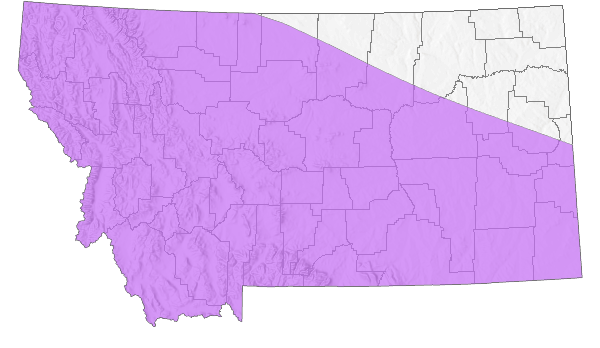
 Native
Native
Range Comments
Alaska to Labrador and south to New England, west to California and Colorado. In Montana, reported on both sides of the Continental Divide from 17 counties. Elevation range is 655 to 2518 m (2150 to 8260 ft). Can be abundant in some localities; 70 were reported at one Glacier County site in Glacier National Park in late August (Hendricks 2012).
Observations in Montana Natural Heritage Program Database
Number of Observations: 74
(Click on the following maps and charts to see full sized version)
Map Help and Descriptions
Relative Density
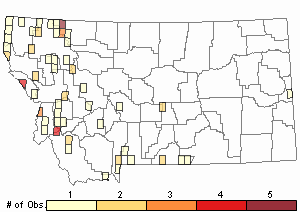
Recency
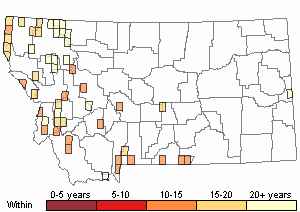
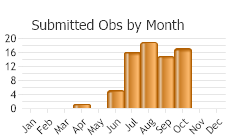
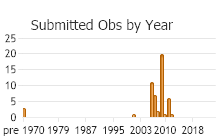
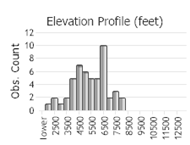 (Observations spanning multiple months or years are excluded from time charts)
(Observations spanning multiple months or years are excluded from time charts)
Habitat
Moist forested or wooded sites, near water, sometimes in campgrounds. Canopy species include western redcedar, western hemlock, grand fir, Engelmann spruce, subalpine fir, Douglas-fir, lodgepole pine, whitebark pine, western larch, ponderosa pine, black cottonwood, and aspen; secondary canopy includes alder, willow, and paper birch. Found on or under rocks and woody debris (sometimes immediately next to streams), in leaf litter or duff, on vegetation (Hendricks 2012).
References
- Literature Cited AboveLegend:
 View Online Publication
View Online Publication Burke, T. E. 2013. Land snails and slugs of the Pacific Northwest. Corvallis, OR: Oregon State University Press. 344 p.
Burke, T. E. 2013. Land snails and slugs of the Pacific Northwest. Corvallis, OR: Oregon State University Press. 344 p. Hendricks, P. 2012. A Guide to the Land Snails and Slugs of Montana. A report to the U.S. Forest Service - Region 1. Montana Natural Heritage Program, Helena, MT. vii + 187 pp. plus appendices.
Hendricks, P. 2012. A Guide to the Land Snails and Slugs of Montana. A report to the U.S. Forest Service - Region 1. Montana Natural Heritage Program, Helena, MT. vii + 187 pp. plus appendices.
- Additional ReferencesLegend:
 View Online Publication
View Online Publication
Do you know of a citation we're missing? Beetle, D.E. 1989. Checklist of recent Mollusca of Wyoming, U.S.A. The Great Basin Naturalist 49(4):637-645.
Beetle, D.E. 1989. Checklist of recent Mollusca of Wyoming, U.S.A. The Great Basin Naturalist 49(4):637-645. Berry, S.S. 1916. Notes of Mollusca of central Montana. Nautilus 29:124-128.
Berry, S.S. 1916. Notes of Mollusca of central Montana. Nautilus 29:124-128. Berry, S.S. 1919. Mollusca of Glacier National Park, Montana. Proceedings of the Academy of Natural Sciences of Philadelphia 71:195-205.
Berry, S.S. 1919. Mollusca of Glacier National Park, Montana. Proceedings of the Academy of Natural Sciences of Philadelphia 71:195-205. Forsyth, R.G. 2004. Land snails of British Columbia. Royal British Columbia Museum: Victoria, British Columbia, Canada. 188 pp.
Forsyth, R.G. 2004. Land snails of British Columbia. Royal British Columbia Museum: Victoria, British Columbia, Canada. 188 pp. Frest, T.J. and E.J. Johannes. 2001. An annotated checklist of Idaho land and freshwater mollusks. Journal of the Idaho Academy of Science 36(2):1-51.
Frest, T.J. and E.J. Johannes. 2001. An annotated checklist of Idaho land and freshwater mollusks. Journal of the Idaho Academy of Science 36(2):1-51. Henderson, J. 1924. Mollusca of Colorado, Utah, Montana, Idaho, and Wyoming. University of Colorado Studies 13(2):65-223.
Henderson, J. 1924. Mollusca of Colorado, Utah, Montana, Idaho, and Wyoming. University of Colorado Studies 13(2):65-223. Henderson, J. 1936. Mollusca of Colorado, Utah, Montana, Idaho, and Wyoming, supplement. University of Colorado Studies 23(2): 81-145.
Henderson, J. 1936. Mollusca of Colorado, Utah, Montana, Idaho, and Wyoming, supplement. University of Colorado Studies 23(2): 81-145. Pilsbry, H.A. 1948. Land Mollusca of North America (north of Mexico), Volume II Part 2. The Academy of Natural Sciences of Philadelphia Monograph Number 2(2): 521-1113.
Pilsbry, H.A. 1948. Land Mollusca of North America (north of Mexico), Volume II Part 2. The Academy of Natural Sciences of Philadelphia Monograph Number 2(2): 521-1113. Squyer, H. 1894. List of shells from the vicinity of Mingusville, Montana. The Nautilus 8:63-65.
Squyer, H. 1894. List of shells from the vicinity of Mingusville, Montana. The Nautilus 8:63-65. Vanatta, E.G. 1914. Montana shells. Proceedings of the Academy of Natural Sciences of Philadelphia 66:367-371.
Vanatta, E.G. 1914. Montana shells. Proceedings of the Academy of Natural Sciences of Philadelphia 66:367-371.
- Web Search Engines for Articles on "Cross Vertigo"
- Additional Sources of Information Related to "Snails / Slugs"





